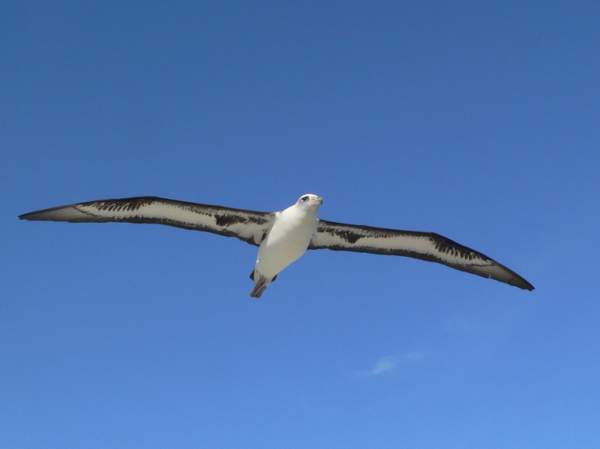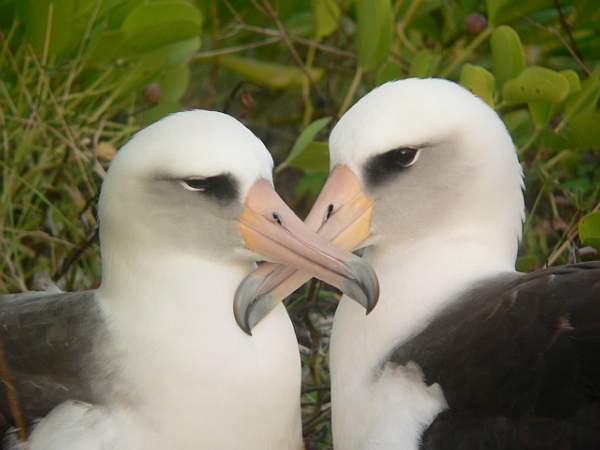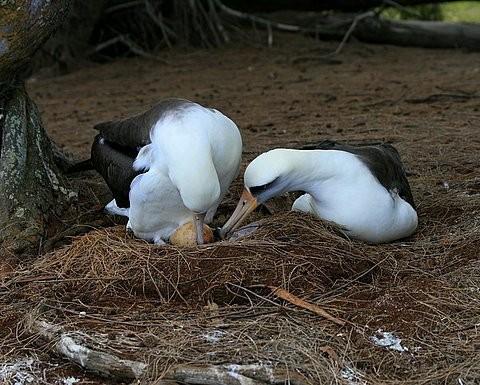Published in the Ocean Watch column, Honolulu Star-Advertiser © Susan Scott
March 13, 2009
Albatross pair works together to hatch an egg It’s a girl!
That was my first thought when I saw the Nature Conservancy’s spring newsletter featuring an article by Hob Osterlund.
This writer-photographer e-mails me and others pictures of, and stories about, a small group of Laysan albatrosses she helps monitor on Kauai.
My surprise, however, wasn’t over the gender of an albatross (both sexes look the same), but by Hob’s. I assumed for more than a year a man was writing me, but the article included a picture.
Hob is a woman who, when not protecting and photographing wildlife, works as a nurse.
You can read about Hob’s unique experience of sitting in an abandoned Laysan albatross nest at www.nature.org/magazine/spring2009/misc/art26925.html. (Update: no longer available)
Most albatross nests this time of year, however, contain not women, but birds.
From June through October albatrosses are loners, soaring the open ocean in search of food. But in November, albatross breeding colonies come alive.

Adult males return to their nest sites first and wait there about eight days for their lifelong mates. An experienced pair’s reunion consists of affectionate preening and bill touching, and within 24 hours they quietly copulate. After this two-minute accomplishment, and some afterglow cuddling, the two head out to sea to fatten up for the lean times ahead.

Another eight days pass before the female returns to lay her egg. Sometimes two females without permanent male partners (mated males cheat) each lay an egg in one nest.
These birds never sit on two eggs, though. Since the females don’t know which egg is which, they pick one, push the other out, and the two moms raise the hatchling together. This is common right now at Kaena Point, which, for reasons unclear, hosts more females than males.
Since producing a fist-size egg takes a lot of energy, the female sits on her new creation only briefly. In two days her mate relieves her, and off she goes for food. The dad is then in for a long haul. About 24 days will pass before the female returns to take her turn.
Subsequent sitting spans are shorter. After five shift changes over 65 days, the egg hatches.
When it doesn’t, though, these birds don’t give up easily. If one is delayed, its partner might stay on the egg for as long as 58 days. If the missing partner has died, and the egg hatches, the chick won’t make it. One parent can’t feed a chick enough to survive.
Other times, both parents are fine but the egg just doesn’t hatch. In these cases the parents continue their incubation shifts long after the due date.
This happened to one couple Hob was watching. After an egg was three weeks overdue, the parents together turned it in the nest and talked to it. Even neighbor albatrosses came over to coax the egg to hatch. Finally, the couple accepted the loss and took off.
But the cold egg served a purpose. Adolescent albatrosses used it to play house, “sitting on it,” Hob writes, “in rehearsal for the Big Time.”
 Photo courtesy of Hob Osterlund
Photo courtesy of Hob Osterlund
Kaena Point is one of the few places in the world you can easily see albatrosses singing, dancing and raising chicks. If you go to this seabird sanctuary, remember that dogs are strictly prohibited, even leashed.
I went there last Sunday and felt lucky to live in a state where I can look up at a bird soaring overhead and think, It’s an albatross!